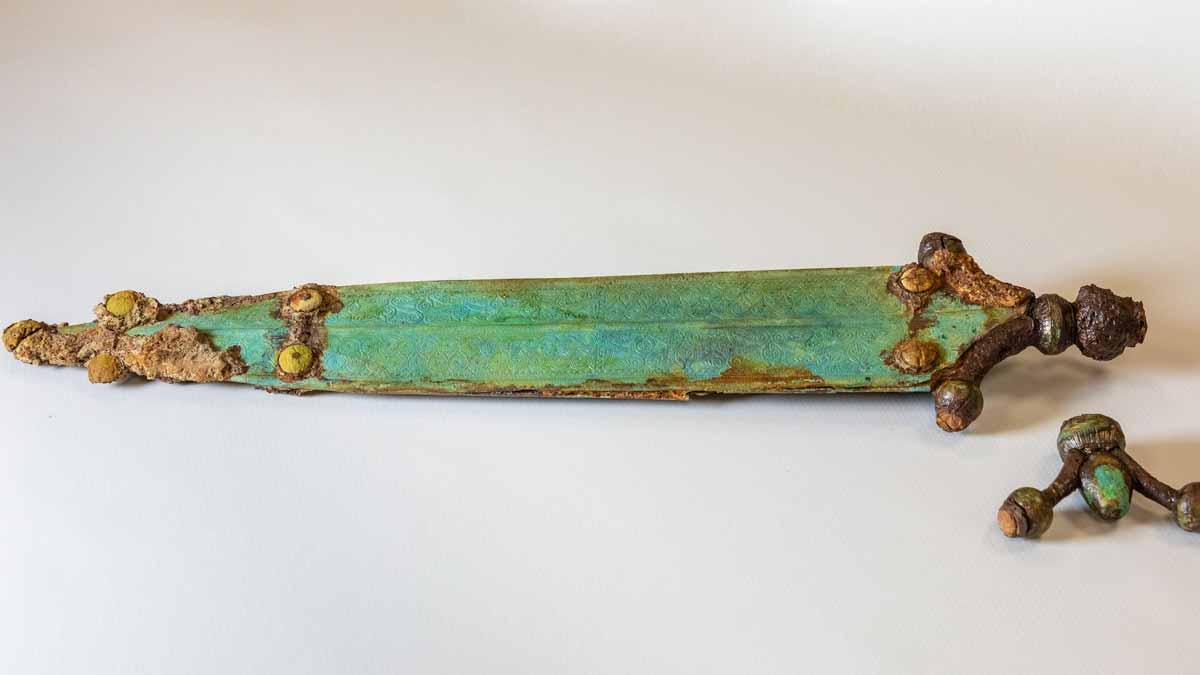A shimmer survives two millennia when metal, glass, and meaning refuse to fade. Here, ornate blades meet ritual, and beauty walks beside war. The objects speak first, and context follows, so the story stays clear and vivid. In this find, ancient symbols connect craft, belief, and power, while careful science restores small clues that time tried to hide.
A vast Celtic necropolis and ancient symbols in plain sight
On a hill above Creuzier-le-Neuf, archaeologists mapped more than one hundred grave pits. The burial ground spans nearly 7,000 square feet and dates to the early fourth century B.C., within La Tène culture. Its quadrangular enclosure, edged by a wide ditch, signals communal action. Rows align north to south, so rites look coordinated rather than rushed.
Bones vanished in acidic soil, yet iron-oxide cocoons fixed metal pieces in place. Almost half of the graves held offerings: jewelry, weapons, or costume fittings. Only one tomb showed cremation, and it included a painted clay vase with red spirals. That design mirrors Mediterranean pottery, so trade felt close, not distant. Routes likely reached the Rhône Valley, where patterns and beliefs, including ancient symbols, traveled with goods.
Craftsmanship, trade routes, and shared La Tène aesthetics
Eighteen fibulas surfaced in fragile bundles, iron and copper-alloy, stabilized at Vienna’s CREAM lab. One brooch carries a silver-leafed gem; another displays ocelli, the eye-like bosses beloved in fifth and fourth-century workshops. Bracelets appeared in pairs, their socketed terminals so precise the clasp line disappears. A matched set bears concentric rings punched deep, with bright hammer marks still visible.
Copper spheres crown some clasps like berries on a stem. The same motif repeats on harness fittings from Champagne burials, about two hundred miles away. That echo points to workshops sharing not only goods but pattern books. So techniques moved, and ideas did too. In turn, small details linked communities across frontiers, as artisans traded style, method, and memory.
Two swords, two stories, and ancient symbols carried with steel
According to INRAP archaeologist Vincent Georges, the longer sword is a working weapon. Its length suits a horseman’s waist, and the scabbard’s edge carries glass-paste cabochons that still glint. X-rays show the belt rings were never pried off, so the fittings stayed intact. Oxidation kept the blade’s geometry, letting conservators measure within two millimeters.
Textile fragments clung to the scabbard back plate, likely from a cloak. The second sword differs by design. It is shorter, leaf-shaped, and clearly ceremonial, with a copper hilt topped by bronze antennae. Georges dates it around the Celtic incursions into northern Italy and the 387 B.C. sack of Rome. Utility meets emblem here, and ancient symbols glide where steel once ruled.
A swastika’s older meaning, celestial motifs, and porous frontiers
Two gems on the ceremonial sheath bear the swastika, a right-angled cross linked to luck and cosmic motion. Historian Lorraine Boissoneault traces that emblem from India to the Mississippi Valley, long before the twentieth century. Classical collections show it spreading across the Mediterranean by the sixth century B.C., then drifting north with migration and exchange.
Here, the motif sits beside a crescent and a full circle inlaid on the blade. The trio suggests solar or celestial meaning, not a boast of battle. This sword adds Western Europe’s earliest example carved into gemstone, a method closer to Hellenistic seal rings. Such hybrid work shows how borders leaked. Craft blended, and ancient symbols shifted shape as they crossed hands.
On the edge of tribal power, identity and memory forged in metal
Creuzier-le-Neuf stood where Arverni, Aedui, and Bituriges lands met, so trade and tension mixed. Mediterranean beads enter local rivers, while Arverni bronze flows south through alpine passes. History recalls the wider Celtic world routing Rome at the Battle of Allia on July 18, 387 B.C. In that climate, a prestige sword doubles as a badge, while its longer twin rides to war.
All three tribes kept fortified oppida within a day’s march. Yet their dead rest together here, which hints at knit families or shared sacred ground. Planned isotope tests on sheath alloys may track ores to Massif Central or farther. Blade edges lack slash notches, so ceremony won. As Benjamin Oury notes, the site is a “classroom” for identity shown in death.
Why these finds reshape memory, trade, and meaning today
Objects speak where voices are gone, and their grammar is exact. The cabochons likely used imported glass, while bracelets mirror La Tène type-A catalog forms. Conservation moves toward display, and residue studies may name lost pigments or textiles. In that light, ancient symbols travel farther than armies, so a sign once meant for thunder now marks a life that chose remembrance. As museums prepare exhibits, context will anchor emotion, preventing sensationalism and encouraging thoughtful public engagement worldwide. Further analyses may link ore sources to networks, tightening timelines and revealing artisans’ journeys across landscapes.
